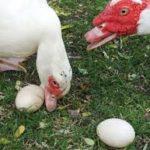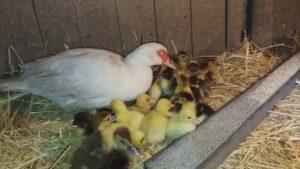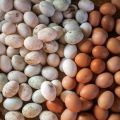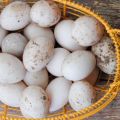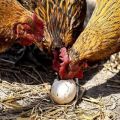An easy way to make an Indo-woman sit on eggs and why she doesn't want to
Many poultry farmers face some kind of difficulties in the process of breeding chicks. There are times when ducks refuse to hatch eggs. This can even happen with musk duck, which has a very developed maternal instinct. The question arises of how to make the Indo-woman sit on the eggs, and what an easy way exists for this.
Selection and preparation of an animal
When choosing a mallard, you must carefully examine the animal. The first thing to look out for is the keel. In its normal state, it is wide enough and has no significant defects. The second point to consider is the distance between the pubic bones. And the last - the coral growths should have a bright color and small size. The younger the bird, the less growth it has.
Since it is not known for sure how a young individual will behave, farmers prefer to take more experienced hens. Females mature at 200 days of age.
The annual rate for this bird is 100-150 eggs. Specific indicators depend on the quality of care of the mallard. Eggs begin to lay in February-March (depending on weather conditions) or a little later (if we are talking about young ducks). The process starts at 6 am and ends after 2 pm.
Preparing the nest
Breeding chicks at home involves preparing the nest. In order for the female to safely sit in her new place and feel comfortable there, it must be positioned correctly. Bird nests should not be close to each other: if one duck has chicks earlier, then other females can follow the brood, leaving their places. It is recommended to make nests from a cardboard box. You can insulate the "house" with hay.
Experts recommend making several nests in different locations.
How to make a muscovy duck sit on eggs
Even if a duck begins to lay eggs, this does not guarantee that she will hatch them. There are a number of reasons that can trigger this behavior:
- eggs are often taken from the female;
- insufficient number of eggs in the clutch (less than 20 eggs);
- parasites or rats in the nest;
- the duck is too young or, on the contrary, old;
- unsuitable conditions (too bright lighting, uncomfortable nest, poor diet, cold, dampness).
Timely detection of the problem, identification and elimination of its cause will allow the female to be safely put in the nest.

To remove ducklings forcibly poultry farmers resort to various tricks:
- Place a false egg in the nest.
- To achieve the required number of eggs (at least 20), the owners take the duck home and wait for the required number to accumulate, and then put the eggs in the nest. They are stored at home at temperatures above 10 degrees. The maximum allowable storage time is 10 days.
- Position the animals so that the brood hen does not overlap with other birds, especially drakes.
Eggs can be taken or laid only when the nest is empty. In this case, the clutches must be kept in perfect order, otherwise the female will find a catch. It is very important that the duck gets used to the nest. For this she will need at least three days.
Caring for hens
The incubation period is about a month. During this time, several important points need to be considered:
- the duck must be protected from negative factors (noise, other birds, etc.) so that nothing distracts it;
- there should be a container with water next to the nest;
- daily diet - dry food;
- provide each bird with a fence so that they can incubate in a calm environment;
- remove spoiled eggs from the clutch (this should be done only in the absence of mother).
After the chicks hatch, they are allowed to be taken away in order to protect them - an inexperienced duck can crush the chick. The first few days, the mother practically does not get up from the nest, then the duck comes out twice a day and does not sit back down for 1-1.5 hours. After the "meal" and bathing, the female returns to her place. Wetting the shell is necessary to wash away the dense layer from the surface of the egg and thereby give the chick the opportunity to breathe. If the duck does not bathe, you will have to wet the masonry yourself.
The appearance of chicks is expected from the 30th day of incubation. As the babies are born, they are taken away, otherwise the bird will stop hatching eggs. When all the young have hatched, the chicks are returned to their mother. During the incubation of the clutch, you need to make sure that the Indo-duck walks for no more than 1-1.5 hours, otherwise the nest will be overcooled. Getting a musky duck to sit on eggs is not as difficult as it might seem at first glance. There are several effective ways to help the owner quickly solve the problem.


